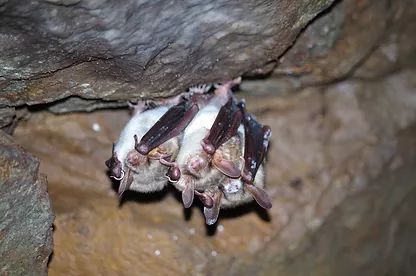Pseudogymnoascus destructans, the causative agent of white-nose syndrome in North America, has drastically decimated bat populations on the North American continent within a decade. The fungus infects bats during hibernation when physiological functions, including immune responses, are downregulated. Studies have shown that P. destructans is originally native to Europe, where it has so far not led to increased mortality. For this reason, various studies have already suggested that European bats have developed an effective immune defence that is lacking in North American bats. However, it is still unclear which concrete defence strategy enables European bats to cope with the pathogen. In this study, therefore, selected physiological and immunological parameters were investigated in hibernating greater mouse-eared bats (Myotis myotis), which are most often affected with the fungus in Europe. Three different levels of infection were compared – asymptomatic, mild and severe infections. In some of the animals studied, skin temperatures were recorded during a month of hibernation to analyze torpor and arousals. It is known that fungus-infested North American little brown bats (Myotis lucifugus) arouse more frequently from the torpor and thus burn their energy reserves prematurely, which partly explains the high mortality. This altered arousal pattern was not detected in fungus-infested greater mouse-eared bats. In contrast to the American bats, which show fever reactions, body temperatures in the greater mouse-eared bats also remained unaffected, despite even severe fungal infections. In general, mouse-eared ears with a higher body weight were more likely to wake up from hibernation and exhibit less severe symptoms of the disease than individuals with lower body weight. This is most likely because the “fatter” bats were able to groom off the fungus more often and thus reduce the infections more often than weaker individuals who could not afford more frequent arousals because of their lower energy budget. As another interesting aspect, higher gene expression values of an inflammatory cytokine (IL-1) were found in the blood of severely infected greater bats than in mildly infected or asymptomatic ones. This indicates an inflammatory reaction of the animals in the torpid state, which is in a way astonishing, because it was previously assumed that the immune system rests during torpor. Interestingly, infected torpid bats relied on baseline concentrations of immunological substances in the blood rather than synthesizing new ones following the infections. We conclude that greater mouse-eared bats tolerate infections with P. destructans during torpor by using selected immune parameters that are still present in some concentration in the blood without synthesizing additional immune molecules. It was concluded that European bats tolerate P. destructans infections by inducing only energetically less costly immune responses to keep their energy-saving regime in order to survive fungal infections during hibernation.

Original study:
Fritze, M., Puechmaille, S. J., Costantini, D., Fickel, J., Voigt, C.C., Czirjok, G. (2021): Determinants of defence strategies of a hibernating European bat species towards the fungal pathogen Pseudogymnoascus destructans. Developmental and Comparative Immunology 119 (2021), 104017.
Link: https://www.sciencedirect.com/science/article/pii/S0145305X21000252?via%3Dihub
